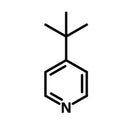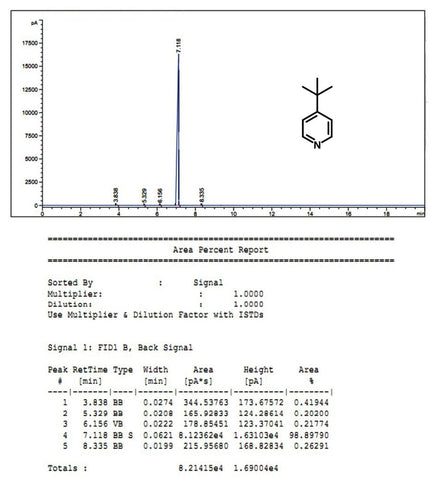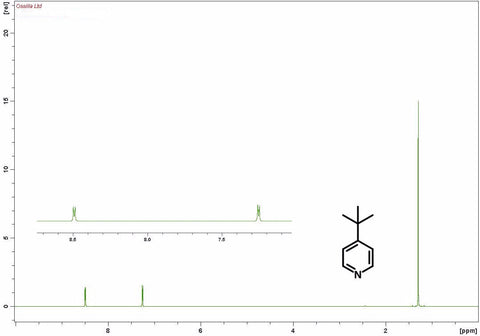4-tert-Butylpyridine
CAS Number 3978-81-2
Materials, Perovskite Interface Materials, Perovskite Materials, Semiconducting Molecules
4-tert-Butylpyridine, high purity semiconducting molecule
An additive in electrolytes of DSSCs and used in HTL materials of PSCs
Overview | Specifications | Literature and Reviews
Together with our ultra pure LiTFSi and sublimed Spiro-MeOTAD, 4-tert-Butylpyridine (also with high purity over 98.0%) is an ideal candidate for your perovskite solar cells research.
General Information
| CAS number | 3978-81-2 |
|---|---|
| Chemical formula | C9H13N |
| Molecular weight | 135.21 g/mol |
| HOMO/LUMO | HOMO 5.9 eV, LUMO 2.4 eV |
| Synonyms | TBP, Pyridine 4-tert-butyl, t-BuPy, tBuPy |
| Classification / Family | Pyridine Derivatives, Dye-Sensitised Solar Cells (DSSC), OLEDs, Perovskite HTL Materials, Electrolyte materials. |
Product Details
| Purity | > 98.0% |
|---|---|
| Boiling point | 196-197 °C (lit.) |
| Density | 0.923 g/mL at 25 °C |
| Colour | Light yellow clear liquid |
Chemical Structure

Applications
4-tert-Butylpyridine (TBP) is widely used as additive in electrolytes of dye-sensitised solar cells (DSSC) and in hole transport layer materials (HTL) of polymer photovoltaics and perovskite solar cells.
Despite the high volatility and unpleasant smell, 4-tert-butylpyridine is usually added into HTM to suppress charge-recombination and further improve the properties of HTM and ensure the high efficiency perovskite solar cells. It has been demonstrated that the flexible and facile use of 4-tert-Butylpyridine can improve the crystallinity of perovskite, PCEs of CH3NH3PbI3-based PSCs were improved from 6.71% to 10.62% (i.e., 58% enhancement) [1].
By introduction of Li-TFSI/TBP additives in poly-3-hexylthiophene HTM for CH3NH3PbI3/P3HT perovskite mesoscopic solar cells, great enhancement of the device efficiency from 5.7% to 13.7% was achieved [2].
| Device structure |
CH3NH3PbI3-based planar PSCs without TBP* [1] |
CH3NH3PbI3-based planar PSCs with TBP [1] |
|---|---|---|
| JSC (mA cm-2) | 17.12 | 21.27 |
| VOC (V) | 0.92 | 0.96 |
| FF (%) | 43 | 52 |
| PCE (best) | 6.71 | 10.62 |
| Device structure |
FTO/bl-TiO2/TiO2/CH3NH3PbI3/ P3HT:LiTFSI/Au [2] |
FTO/bl-TiO2/TiO2/CH3NH3PbI3/ P3HT:LiTFSI:TBP/Au [2] |
|---|---|---|
| JSC (mA cm-2) | 15.5 | 20.1 |
| VOC (V) | 0.67 | 0.92 |
| FF (%) | 55 | 74 |
| PCE (best) | 5.7 | 13.7 |
*4-tert-Butylpyridine as an additive resulted in orientational and better crystallinity
Characterisation (NMR and HPLC)


Literature and Reviews
- Effects of 4-tert-butylpyridine on perovskite formation and performance of solution-processed perovskite solar cells, Y. Shi et al., J. Mater. Chem. A, 3, 22191-22198 (2015). DOI: 10.1039/C5TA05988G.
- CH3NH3PbI3/poly-3-hexylthiophen perovskite mesoscopic solar cells: Performance enhancement by Li-assisted hole conduction, J-H. Heo et al., Phys. Status Solidi RRL 8, No. 10, 816–821 (2014). DOI 10.1002/pssr.201409330.
- Influence of alkylpyridine additives in electrolyte solution on the performance of dye-sensitized solar cell, H. Kusama et al., Sol. Energy Mater. Sol. Cells, 80, 167–179 (2003). doi:10.1016/j.solmat.2003.08.001.
